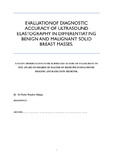Evaluation of diagnostic accuracy of ultrasound elastography in differentiating benign and malignant solid breast masses.
Abstract
Objective
The purpose of this study was to determine the diagnostic accuracy of breast ultrasound
elastography in differentiating benign from malignant breast masses using histology
diagnosis as the gold standard.
Material and Method
The study was carried out at Kenyatta National Hospital. 112 patients with solid breast lumps
were reviewed. They fulfilled our inclusion criteria gave consent to standard breast
ultrasound supplemented by strain elastography. The imaging was carried out using a logic E-
9 GE Ultrasound machine with Elastography software packages. A specifically designed data
collection form was used to record the demographic details of the patient, the clinical
findings, gray scale and ultrasound elastography findings and the histological diagnosis.
Histopathologic results and strain elastography results were correlated.
Results
Female patients accounted for 96.5% of the total number of patients reviewed. The age range
was 15-79 years. The median age of presentation was 28 years (interquartile range 22 – 40).
Using ultrasound elastography to differentiate benign and malignant breast lumps, with
histology as the gold standard, the sensitivity for strain score and strain ratio was 92.9% and
96.4% respectively. Specificity was however the same for both (95.2%).Strain ratio yielded a
higher sensitivity compared to elasticity score (96.4% versus 92.9%). However, strain ratio
against elasticity score were positively correlated with a Spearman’s coefficient of 0.7842 (P
value <0.001) indicating that by performing both techniques, a more confident diagnosis can
be made.
Conclusion
Strain elastography is a non invasive, fast, simple tool that can compliment conventional gray
scale ultrasound of the breast. It has a high accuracy level and could be used as a good tool
for the classification of breast masses prior to the decision to biopsy a lesion.
Publisher
University of Nairobi

